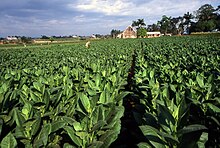
Cuban cigars are cigars manufactured in Cuba from tobacco grown within that island nation.[1] Historically regarded as among the world's "finest", they are synonymous with the island's culture and contribute over one quarter of the value of all exports from the country. The filler, binder, and wrapper may come from different areas of the island, though much is produced in Pinar del Río province, in the regions of Vuelta Abajo and Semi Vuelta, as well as in farms in the Viñales region.[2] All cigar production in Cuba is controlled by state-owned Cubatabaco. The Cuban cigar is also referred to as El Habano.[3]

Cubatabaco and Habanos SA – held equally by the Cuban state and Spanish-based private enterprise Altadis – do all the work relating to Cuban cigars, including manufacture, quality control, promotion and distribution, and export.[4] Habanos SA handles export and distribution, largely through its European partner Altadis.[5] All boxes and labels are marked Hecho en Cuba (Spanish for 'Made in Cuba'). Machine-bunched cigars finished by hand add Hecho a mano ('handmade'), while fully handmade cigars say Totalmente a mano ('entirely handmade'). Torcedores, skilled workers who roll cigars by hand, are highly respected in Cuban society and culture, and travel worldwide displaying the art of hand-rolling cigars.[6] Today, most torcedores are women, or torcedoras.[7]
- ^ Vick, Karl (2015-06-13). "Wrapped Up in Mystique". TIME. Retrieved 2024-12-05.
- ^ Simoni, Valerio (1 November 2009). "Scaling cigars in the Cuban tourism economy". Etnografica. 13 (2): 417–438. doi:10.4000/etnografica.1331. ISSN 0873-6561.
- ^ Cite error: The named reference
:2was invoked but never defined (see the help page). - ^ "Top 50 Best High-End (Cuban) Cigar Brands, Makers & Online Suppliers". www.theinternationalman.com. Retrieved 2024-12-05.
- ^ Cite error: The named reference
:4was invoked but never defined (see the help page). - ^ Rivera, Maricarmen (29 April 2002). "Cuban Gold Gets Rolled in Vineland / Store Offers Cigars Rolled by Cuban Hands". The Press of Atlantic City. Retrieved 8 March 2009.
- ^ The World of the Habano. Tobacco Research Institute / Instituto de Investigaciones del Tabaco. 2012. p. 54. ISBN 978-959-7212-05-8.
